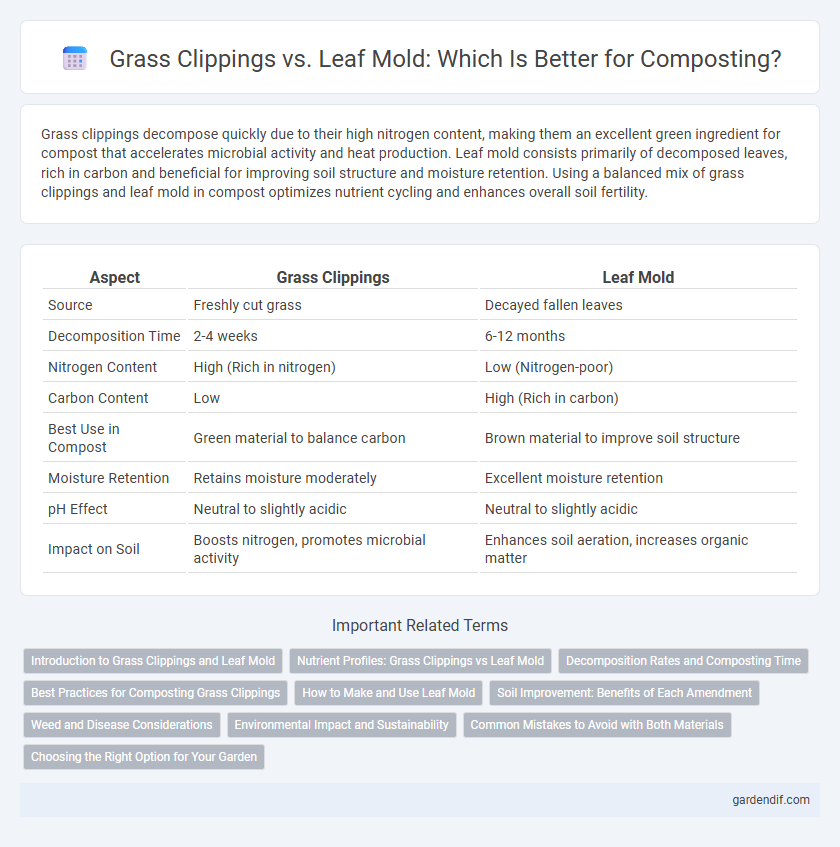
Grass Clippings vs Leaf Mold Illustration
Grass clippings decompose quickly due to their high nitrogen content, making them an excellent green ingredient for compost that accelerates microbial activity and heat production. Leaf mold consists primarily of decomposed leaves, rich in carbon and beneficial for improving soil structure and moisture retention. Using a balanced mix of grass clippings and leaf mold in compost optimizes nutrient cycling and enhances overall soil fertility.
Table of Comparison
| Aspect | Grass Clippings | Leaf Mold |
|---|---|---|
| Source | Freshly cut grass | Decayed fallen leaves |
| Decomposition Time | 2-4 weeks | 6-12 months |
| Nitrogen Content | High (Rich in nitrogen) | Low (Nitrogen-poor) |
| Carbon Content | Low | High (Rich in carbon) |
| Best Use in Compost | Green material to balance carbon | Brown material to improve soil structure |
| Moisture Retention | Retains moisture moderately | Excellent moisture retention |
| pH Effect | Neutral to slightly acidic | Neutral to slightly acidic |
| Impact on Soil | Boosts nitrogen, promotes microbial activity | Enhances soil aeration, increases organic matter |
Introduction to Grass Clippings and Leaf Mold
Grass clippings are nitrogen-rich organic waste that decomposes quickly, providing essential nutrients to compost and improving soil fertility. Leaf mold, formed from decomposed fallen leaves, is a carbon-rich material that enhances soil structure and moisture retention. Combining grass clippings and leaf mold balances the compost's carbon-to-nitrogen ratio, optimizing microbial activity and nutrient cycling.
Nutrient Profiles: Grass Clippings vs Leaf Mold
Grass clippings are rich in nitrogen, making them a valuable green material that accelerates decomposition and boosts microbial activity in compost. Leaf mold, primarily composed of decomposed leaves, provides a slow-releasing source of carbon and enhances soil structure without significantly adding nitrogen. Combining grass clippings and leaf mold balances nutrient profiles, promoting a well-rounded, nutrient-rich compost ideal for healthy plant growth.
Decomposition Rates and Composting Time
Grass clippings decompose rapidly due to their high nitrogen content, typically breaking down within 2 to 4 weeks in a well-managed compost pile. In contrast, leaf mold primarily consists of carbon-rich fallen leaves, requiring several months to over a year to fully decompose and transform into nutrient-rich humus. Composting time for grass clippings is significantly shorter, making them ideal for quick green matter turnover, whereas leaf mold enhances soil structure through slower, long-term decomposition.
Best Practices for Composting Grass Clippings
Grass clippings are rich in nitrogen, making them an excellent green material to balance carbon-heavy components like dried leaves or wood chips in a compost pile. To prevent clumping and odor, spread grass clippings in thin layers and mix thoroughly with brown materials such as straw or shredded leaves, ensuring proper aeration and moisture for efficient decomposition. Avoid using grass treated with herbicides or pesticides to maintain compost quality and plant safety.
How to Make and Use Leaf Mold
Leaf mold is created by piling up fallen leaves in a shady, moist area and allowing them to decompose naturally over 6 to 12 months, resulting in a dark, crumbly soil conditioner rich in organic matter. Unlike grass clippings, which break down quickly and can mat if not mixed properly, leaf mold improves soil structure and water retention without adding excess nitrogen. Use leaf mold by incorporating it into garden beds or potting mixes to enhance microbial activity and promote healthier plant growth.
Soil Improvement: Benefits of Each Amendment
Grass clippings provide a rich source of nitrogen, accelerating microbial activity and improving soil structure by enhancing moisture retention and aeration. Leaf mold, composed of decomposed leaves, offers a slow-release supply of organic matter that boosts soil fertility by increasing humus content and supporting beneficial fungi. Both amendments improve soil quality, with grass clippings promoting rapid nutrient cycling and leaf mold enhancing long-term soil health through improved texture and nutrient availability.
Weed and Disease Considerations
Grass clippings tend to harbor fewer weed seeds due to regular mowing, reducing the risk of weed proliferation in compost, while leaf mold can sometimes contain dormant seeds or fungal spores that might introduce diseases. Properly managed composting of grass clippings, which often have higher nitrogen content, helps generate heat that suppresses weed seeds and pathogens effectively. Leaf mold, rich in lignin and cellulose, requires longer decomposition, and if not fully broken down, it may carry a higher chance of harboring diseases or weed seeds into garden soil.
Environmental Impact and Sustainability
Grass clippings decompose rapidly, enriching soil with nitrogen and reducing landfill waste, while leaf mold improves soil structure and moisture retention by recycling carbon-rich leaves. Both materials enhance garden sustainability by minimizing chemical fertilizer use and promoting organic matter cycling. Choosing local resources, such as grass clippings or leaf mold, supports eco-friendly composting and reduces transportation-related carbon emissions.
Common Mistakes to Avoid with Both Materials
Common mistakes with grass clippings include adding them in thick layers, which can lead to anaerobic conditions and foul odors, and failing to mix them properly with carbon-rich materials to maintain a balanced compost pile. Leaf mold errors often involve using freshly fallen leaves without adequate shredding, resulting in slow decomposition and compact layers that hinder airflow. Avoiding these errors by managing moisture levels and ensuring proper aeration enhances the efficiency and quality of compost derived from both grass clippings and leaf mold.
Choosing the Right Option for Your Garden
Grass clippings are rich in nitrogen, providing a quick boost to your compost pile and enhancing soil fertility, while leaf mold, composed of decomposed leaves, offers a slow-release source of organic matter that improves soil structure and moisture retention. Selecting the appropriate option depends on your garden's nutrient needs and soil condition; grass clippings suit rapid nutrient replenishment, whereas leaf mold is ideal for enriching garden beds and promoting long-term soil health. Balancing the two materials in your compost strategy optimizes nutrient cycling and supports sustainable plant growth.
Grass Clippings vs Leaf Mold Infographic

 gardendif.com
gardendif.com